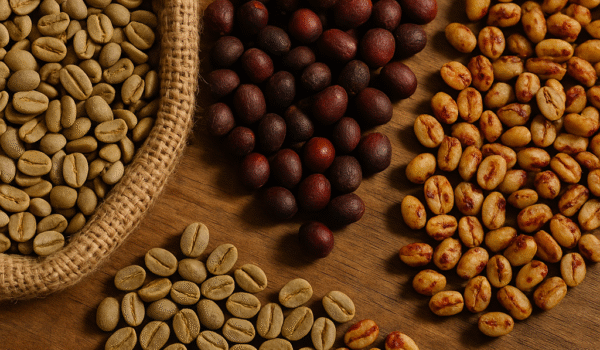Your cart is empty.
The Influence of Processing Methods on Exclusive Coffee Profiles

How Fermentation, Drying, and Craft Transform the Taste of Rare Beans
When it comes to exclusive coffee, origin and varietal are only part of the story. What truly shapes a coffee’s character—sometimes more than its geography—is the processing method it undergoes after harvest. From bright and floral to funky and winey, the same bean can taste radically different depending on how it’s processed.
For connoisseurs seeking to understand what makes high-end coffees so expressive, the post-harvest process is where the magic (or the misstep) often happens.
Let’s dive deep into how various processing methods influence the flavor profile, texture, and complexity of exclusive coffees.
1. Washed (Wet) Process – Clean, Bright, Transparent
What it is:
In the washed method, coffee cherries are depulped, then fermented to remove the mucilage, and thoroughly washed before drying.
Flavor Impact:
Bright acidity
Clean and crisp flavors
Distinct origin characteristics
Great for highlighting terroir
Best Examples:
Ethiopian Yirgacheffe
Kenyan AA
Panamanian washed Geisha
Washed coffees are often preferred in competitions and cuppings because they allow the purest expression of the bean and its origin.
2. Natural (Dry) Process – Fruity, Bold, Complex
What it is:
Cherries are dried whole, often under the sun, before the dried fruit is removed.
Flavor Impact:
Strong berry or stone fruit notes
Heavy body
Fermenty, sometimes funky tones
Wine-like finish
Best Examples:
Natural Brazil
Yemen Haraaz
Ethiopia Sidamo Natural
processing method – Natural processing adds layers of wild, juicy complexity, making it popular among lovers of experimental, bold coffees. However, it’s also more prone to defects if not carefully managed.
3. Honey (Semi-Washed) Process – Balanced, Sweet, Smooth
What it is:
A hybrid method where mucilage is left partially or entirely on the bean during drying.
Flavor Impact:
Balanced acidity and sweetness
Syrupy body
Notes of honey, caramel, or red fruits
Less fermented than naturals, more depth than washed
Best Examples:
Costa Rica Yellow or Black Honey
El Salvador Honey Process
The honey process is a favorite among roasters for its ability to deliver sweetness and complexity without overwhelming fruitiness.
4. Anaerobic Fermentation – Funky, Unpredictable, Experimental
What it is:
Cherries or depulped beans are fermented in oxygen-free tanks to control microbial activity.
Flavor Impact:
Intense, layered complexity
Tropical fruits, spices, bubblegum, even balsamic
Funky, fermented notes
Can be polarizing
Best Examples:
Colombian anaerobic naturals
Costa Rican experimental lots
Ninety Plus Gesha anaerobics
In the world of cutting-edge specialty coffee, anaerobic processes are redefining flavor expectations—and setting records at auctions.
5. Carbonic Maceration – Borrowed from Winemaking
What it is:
Whole cherries are fermented in sealed tanks filled with carbon dioxide, similar to techniques used in fine wine.
Flavor Impact:
Clean, bright acidity
Velvety texture
Flavors of red grapes, hibiscus, and tropical fruits
Long, elegant finish
Best Examples:
Panama Gesha experimental lots
El Paraiso (Colombia) CM processed beans
This method produces coffees with depth and elegance, often featured in global barista championships.
6. Double/Extended Fermentation – Bold, Deep, Structured
What it is:
Beans undergo two fermentation stages—either wet/dry or aerobic/anaerobic—to enhance flavor development.
Flavor Impact:
Dense sweetness
Spice notes (clove, cinnamon)
Chocolate or port wine finish
Layered mouthfeel
Best Examples:
Finca Deborah (Panama)
Colombian extended fermentation naturals
These coffees are made with extreme attention to detail, requiring careful timing and environmental control. The result is often spectacular.
Processing and Price: Why It Matters
Processing isn’t just a flavor influencer—it’s a key value driver in the exclusive coffee market.
Labor-intensive methods like anaerobic or CM command higher prices
Experimental lots with unique fermentation styles often win awards and auctions
Transparent processing stories build consumer trust and brand prestige
In short, when you pay a premium for exclusive coffee, you’re not just buying a bean—you’re buying a process.
Final Pour: The Craft Behind the Cup
The next time you sip a rare single-origin or micro-lot coffee, take a moment to ask:
“How was this processed?”
Because in that answer lies the key to why it tastes the way it does, and why it matters. Understanding processing methods unlocks a deeper appreciation for the invisible artistry behind every exclusive cup.
processing method – So whether you love a fruity natural, a crisp washed, or a wild anaerobic fermentation, remember: great coffee doesn’t just grow—it’s crafted, post-harvest, with passion and precision.






